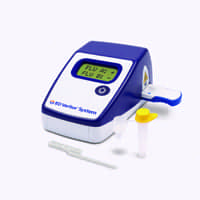A new report that detailed how rapid diagnostic tests (RDTs) for influenza used by individuals at home could potentially expand access to testing and reduce the impact of influenza on health systems was recently published by JMIR Publications.
The report, “Diagnostic Accuracy of an At-Home, Rapid Self-test for Influenza: Prospective Comparative Accuracy Study”, published in JMIR Public Health and Surveillance showed how improving access to testing could lead to earlier diagnosis following symptom onset, allowing more rapid interventions for those who test positive, including behavioral changes to minimize spread.
Rapid Testing Study
This study aims to assess the accuracy of an influenza RDT conducted at home by lay users with acute respiratory illness compared with that of a self-collected sample by the same individual mailed to a laboratory for reference testing.
Participants were mailed the influenza RDT and reference sample collection materials, which they completed and returned for quantitative reverse-transcription polymerase chain reaction (RT-PCR) influenza testing in a central laboratory.
The JMIR Public Health and Surveillance authors explored the impact of age, influenza type, duration, and severity of symptoms on RDT accuracy and on cycle threshold for influenza virus and ribonuclease P, a marker of human DNA.
The overall sensitivity and specificity of the RDT compared with the reference test were 61% and 95%, respectively.
“In the most recent influenza season in the United States (October 2019 to April 2020), an estimated 39 to 62 million people were infected, resulting in 18 to 26 million health care visits and 24,000 to 62,000 deaths,” says Matthew J Thompson, MD, MPH, PhD, from The University of Washington.
Diagnosis of influenza based on clinical features alone is inaccurate; therefore, several clinical guidelines support laboratory testing of respiratory tract specimens to detect the influenza virus.
Increasingly, laboratory testing for influenza has shifted to in-clinic testing using point-of-care (POC) devices.
Rapid diagnostic tests are a class of POC tests that can be performed with a few simple steps and typically do not require instrumentation or special supplies, raising the possibility for untrained individuals to use these tests outside of clinical settings.
Focus on Home Testing
RDTs tested in routine health care settings have shown sensitivities and specificities of 60% to 70% and 90% to 100%, respectively; however, owing to the novelty of home testing, few RDTs have been studied in the home environment.
A primary hurdle to at-home testing for influenza or other respiratory viruses is that RDTs are typically less accurate than laboratory-based assays, even when used by health care workers.
Thompson and the research team concluded in their JMIR Publications Research Output that, using an entirely community-based remote recruitment study design, their findings showed that the Ellume Home Flu Test (EHFT) had comparable accuracy to many influenza RDTs used in clinical settings.
However, the sensitivity of the EHFT was only moderate and was higher when the test was used within 72 hours of symptom onset when virus shedding was likely the highest. Their findings support a new form of trial design, in which recruitment and self-sampling for reference testing can be performed successfully by lay users in the communities and populations in which these tests will be implemented.
Such study designs could be used to assess the accuracy of tests for other viral respiratory tract pathogens, such as SARS-CoV-2 and respiratory syncytial virus.
Home tests have the potential to expand access to testing for infectious diseases, with potential benefits for individuals and the health care system.
Featured image: A photo of the Seattle Flu Study’s “Swab and Send” kit. Source: Brotman Baty Institute; Copyright: Brotman Baty Institute; License: Creative Commons Attribution (CC-BY)





